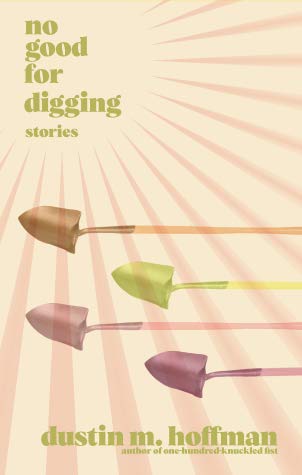
by Beret Olsen
Dustin M. Hoffman’s latest short story collection, No Good for Digging (word west 2019), opens with “A Nesting,” two perfect paragraphs hovering on a white page. In it, a family of birds is trapped in the Sheetrock as a house is built.
“We blamed the drywallers and they blamed the framers and they blamed the landscapers. But we all carried hammers. They hung at our hips, nestled in our truck beds, rested like the dead in toolbox caskets. Any one of us could have punched a hole and turned finished walls to fluttering.”
Equal parts poetic and plainspoken, Hoffman leaves the reader breathless, trapped in the walls with the birds. It is a brilliant start.
No Good comprises thirty-one stories varying widely in form and substance. A piece might span ninety-five words or ten pages; it might be fantastic, realistic, or surreal. One moment we are floating on hands at a punk rock show, the next chatting with the farmer who tends to our balding scalp; we are a parent, a child, a housepainter, a plate. At a time when many short story collections are distilled into smooth blends, it is refreshing to be surprised on each new page.
Yet something about that first story lingers throughout all those that follow: Hoffman is continually venturing in and out of boundaries, perhaps most at home in the stuff in between. His narrative arc ends before a demented game of hide and seek. Readers may never know if grandma is dead or alive, or whether Barry’s assistant will emerge successfully from the Escape Cube. The author plays in those breezeways between life and death, flesh and object, self and other.
At times the passage between the two is intensely visceral. In “My Pupils, Dive Sites,” two women in wetsuits slice into the narrator’s corneas and enter.
“…through the slit Short Hair kicks, thigh-thrumming ingress, into pupil gloom, brushing black walls with gloved fingertips…I feel them swallowed, the guideline deadly slack. I blink to remind them how much they are loved, missed, wishing for safe return to surface, to my vision, my selfish need to see the outside of things.”
Hoffman’s fictional worlds might not follow the rules and logic of ours, but he pokes into raw truths in ways traditional prose might not reach. Imagine one’s heart re-envisioned as an all-night diner—what might that be like?—or a love affair sorted into the stages of its evolution: “When you and I turned into snails, I tore myself from my shell, and we squeezed into yours. We pressed against your spirals and they stabbed my flesh, made me secrete unintentionally. But you laughed it off and scooched over for me” (from “When We”).
In most stories, even some with the sharpest of teeth, the author manages to include a great deal a humor. Slung across multiple pages, “Pitch” is a single hilarious and devastating sentence, as spoken by a loquacious deck salesman. He begins his pitch reminiscing about the potential client’s first crush—which, after “perpetual quantum giddiness” and a kiss, ended in her first real disillusionment—then rehashes the disappointments and heartbreaks that followed, casting doubt and growing dissatisfaction over everything including her body-image, grown children, and current marriage, all while describing how an Ultra-Syntho-Balsa deck—especially one with the Remote-Laxer-Awnings added—could help her achieve a level of contentment she has not yet achieved. All for just forty-six easy payments.
Don’t get too comfortable. Like “A Nesting,” other stories do not allow the reader room to breathe. In these, Hoffman is not afraid to cut close to the bone. Near the end of the book, “No Good for Digging” appears, and light phrases about wet socks and childish digging skills do not ease the heft and punch of the story.
With such variety, there are bound to be a few offerings that challenge the reader’s palate—the proverbial coconut creams in the candy box. Though disorientation is part of the fun, placement of a couple of the stories was jarring, and the overall mix might have benefitted from the removal of one or two of the longer ones. However, these are small glitches in an inventive and haunting collection. Hoffman has balanced gravity and humor into melancholic fables without moral or resolution, many of which linger long after closing the cover.
_______________________
 Beret Olsen is a writer, a photographer, and the photo editor for 100 Word Story. Her art, essays, and fiction have appeared in publications including First Class Lit; Flash: The International Short-Short Story Magazine; the Masters Review; and her blog, Bad Parenting 101.
Beret Olsen is a writer, a photographer, and the photo editor for 100 Word Story. Her art, essays, and fiction have appeared in publications including First Class Lit; Flash: The International Short-Short Story Magazine; the Masters Review; and her blog, Bad Parenting 101.

 The core workshop of SmokeLong Fitness is all in writing, so you can take part from anywhere at anytime. We are excited about creating a supportive, consistent and structured environment for flash writers to work on their craft in a community. We are thrilled and proud to say that our workshop participants have won, placed, or been listed in every major flash competition. Community works.
The core workshop of SmokeLong Fitness is all in writing, so you can take part from anywhere at anytime. We are excited about creating a supportive, consistent and structured environment for flash writers to work on their craft in a community. We are thrilled and proud to say that our workshop participants have won, placed, or been listed in every major flash competition. Community works.